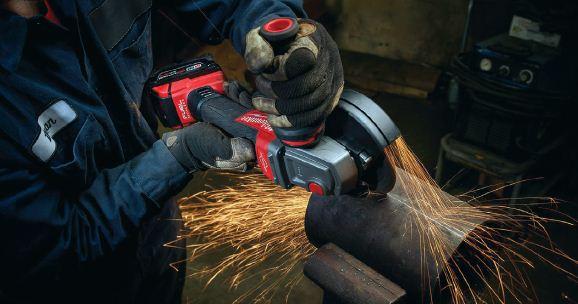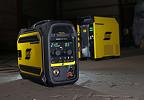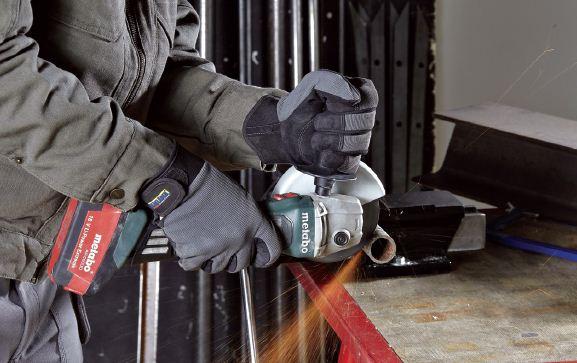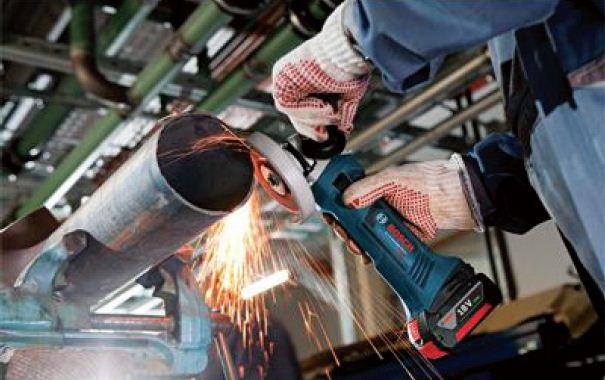- FMA
- The Fabricator
- FABTECH
- Canadian Metalworking
Grind Away
Proper tools necessary for removing material.
- By Nestor Gula
- November 11, 2015
- Article
- Metal Finishing
Angle grinders are simple tools. On the surface it is just a motor, a transfer case and grinding disk or cut-off wheel. These simple machines have been around for ages and can be picked up at the local hardware store very inexpensively.
A proper and well-designed angle grinder is not such a simple machine. “A high-end grinder should be extremely durable, high performance, safe and ergonomic,” says Randy McDonald national sales manager at Fein Canadian Power Tool Company. “It should be designed for continuous use, even in the toughest of applications. High-end grinders feature higher motor outputs, which means constant speed and torque which leads to higher productivity. They are typically more energy efficient as well.”
Having steel gears in the nose of the grinder results in a durable unit. “These units may be a higher cost initially but will pay for themselves in terms of not having to be replaced as quickly,” says Keith Potts, national trainer for Milwaukee Electric Tool.
“Electronics that shut the unit down if jammed into material to protects it. Electronic clutches that work in a similar fashion, and also CPT, or Constant Power Technology, electronics that keep the same RPMs in any materials, which is critical in cutting and polishing operations when using flap wheels and wire cups etc. is also helpful when using grinding wheels where long consistent performance is required.
Angle grinders work under considerable load so “maintaining a constant RPM is a critical factor,” according to Max Bezner, national sales manager with Metabo Canada.
But anyone who has used an inexpensive angle grinder for an extended period of time, even 10 minutes, will tell you that the vibrations of such a machine has caused a considerable amount of discomfort in their hands, wrist and elbows at the very least.
“Disorders like hand-arm vibration syndrome can be a side effect of too much vibration,” notes Steve Wilcox, group marketing manager at Robert Bosch Tool Corp. It is essential to get a properly engineered and balanced tool because prolonged use of an angle grinder can lead to health issues including white finger syndrome and tendonitis.
“Using an unbalanced grinder is simply not efficient; there is a lower removal rate and a short life span of the consumables being used,” says Stephane Drainville, product manager at Walter Surface Technologies. “A grinding wheel will generate a lot more dust and it will disintegrate faster than it should. There is also a very important issue concerning safety: vibration while cutting with a thin cutting wheel is more vulnerable to breakage. You don’t want breakage.”
Worker fatigue due to excessive vibration is a serious issue as it affects productivity. “The worker can become tired, stressed and even weak when faced with using tools that have high vibration levels,” says McDonald.

Cut off wheels are great for cutting awkward objects. IMAGE COURTESY OF MILWAUKEE ELECTRIC TOOL CORPORATION
“This translates into less productivity, possible time off, and potential compensation implications.”
High-end grinder manufacturers engineer and design their tools to eliminate unwanted vibration. “When the armature of the angle grinder is built, it goes into an automated balancing machine,” explains Drainville. “This machine will spin the armature at a regular usage level and will automatically detect which side of the armature is unbalanced. Then, a small grinding wheel will remove the unnecessary material. It will start spinning again and continue the same process to be sure the operation was performed well.”
The easiest way for users to minimize vibration is to choose tools that have documented vibration emission values that meet national or international standards criteria.
“High-end manufacturers have this information available either in the manuals that come with the tools or on their websites” says McDonald.
“Another option is vibration-dampening gloves or vibration dampening handles (if required). But in the end, using tools that significantly reduce vibration in the first place is the best solution.”
The consumable factor
Using proper consumables, grinding disks or cut-off wheels, will also reduce vibration and unnecessary strain on operators. “Operators will not only have a better balanced angle grinder, but switching to a more durable abrasive they will also significantly reduce their labor costs,” says Drainville. “The Walter Documented Cost Savings program was designed to demonstrate how using our products can assist in lowering long-term expenses. We encourage abrasives users to download the online white paper.”
A good quality consumable provides the user with the best performance since they offer better removal rates; while at the same time have longer product life. “Users are more productive since they dramatically reduce the amount of wheel changeovers,” he adds. “Normally, poor quality consumables are very low priced but they cost you more at the end of the day since you are consuming more wheels and take more time to get the job done. At the end, users who buy quality are saving time and money.”
In addition, quality consumables, made with premium materials (resin, grains, and reinforcements) will effect the grinder performance.
“Just like high-end tool manufacturers, high-end abrasive manufacturers produce wheels to the highest of safety standards,” says McDonald. “High performance wheels are balanced to ensure that they run straight and smooth. Choosing the correct wheel for the material and application is critical for the performance of an angle grinder. But most of all it is critical for the safety of the operator.”
Going wireless
Most angle grinders are wired, but with the advent of more powerful and longer lasting batteries cordless angle grinders are becoming more accepted in industrial applications.
“Brushless units have similar performance to corded units now. 18-volt units used to be categorized as cutting units only until recently, now with FUEL brushless technology the units can serve as cutter and grinder,” says Potts.
“The new brushless tools with LiHD high density lithium battery packs are making cordless grinding a viable option without sacrificing performance,” says Bezner.
“The weight of the cordless angle grinder is similar to that of the corded version, although there is a medium-sized and heavy battery attached to the grinder,” says Wilcox. “A good cordless grinder requires that balance be accurately equalized across the entire width of the tool while the user is grinding. So the ergonomics of a cordless grinder are similar to what’s required in a corded grinder. As with weight, ergonomics need to be well optimized considering the attached battery adds a little bulkiness. As a general rule, ergonomic designs usually have additional slimness at the center of the grinder handle.”
The design of cordless angle grinders differs from their corded cousins as they have permanent magnets in them, which can cause problems. “Grinding, sanding and cutting applications will generate dust that must at all cost never enter inside the cordless grinder,” says Drainville. “All particles that will be sucked inside the cordless tool will be attracted by the permanent magnet, and you won’t be able to remove it even using an air gun. That’s why cordless grinders without a dust guard protection have a very poor life, being short-circuited by the accumulated dust.”
As the technology evolves cordless angle grinders will become more ubiquitous in industrial applications.
About the Author
subscribe now


Keep up to date with the latest news, events, and technology for all things metal from our pair of monthly magazines written specifically for Canadian manufacturers!
Start Your Free Subscription- Trending Articles
CWB Group launches full-cycle assessment and training program

Achieving success with mechanized plasma cutting

3D laser tube cutting system available in 3, 4, or 5 kW

Brushless copper tubing cutter adjusts to ODs up to 2-1/8 in.

Welding system features four advanced MIG/MAG WeldModes

- Industry Events
MME Winnipeg
- April 30, 2024
- Winnipeg, ON Canada
CTMA Economic Uncertainty: Helping You Navigate Windsor Seminar
- April 30, 2024
- Windsor, ON Canada
CTMA Economic Uncertainty: Helping You Navigate Kitchener Seminar
- May 2, 2024
- Kitchener, ON Canada
Automate 2024
- May 6 - 9, 2024
- Chicago, IL
ANCA Open House
- May 7 - 8, 2024
- Wixom, MI

















